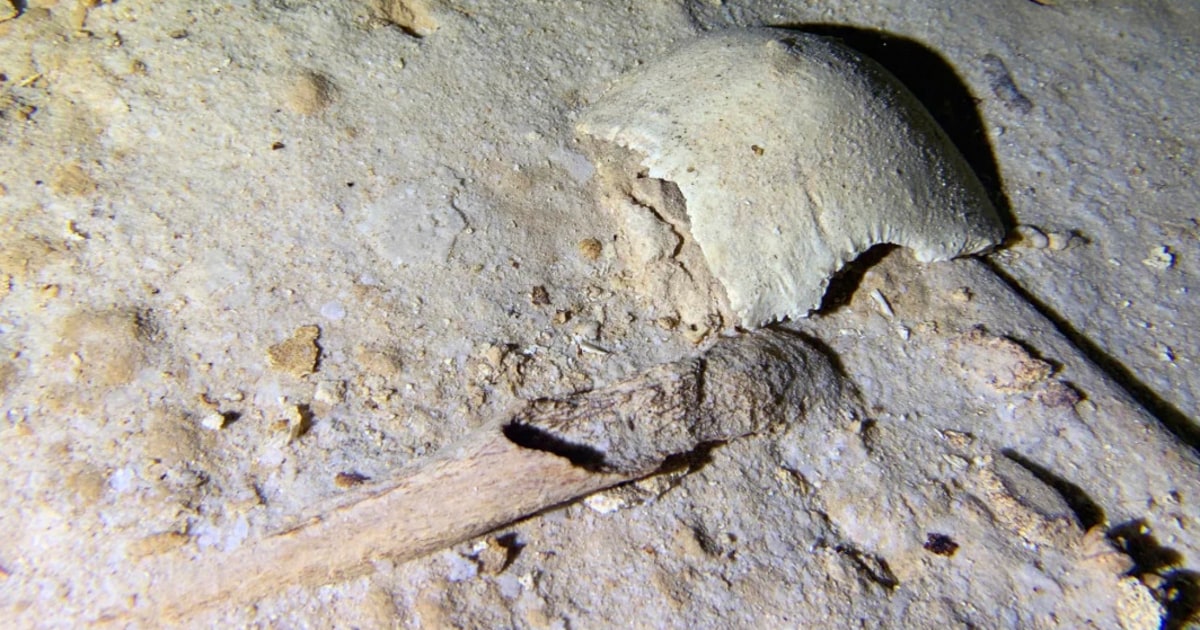By
Associated Press
A prehistoric human skeleton has been found in a cave system that flooded at the end of the last ice age 8,000 years ago, according to a cave-diving archaeologist off Mexico's Caribbean coast in the Riviera Maya.
Octavio del Río said he and his colleague Peter Broger saw the shattered skull and skeleton partially covered by sediment in a cenote, or submerged cave, near where the Mexican government plans to build a high-speed tourist train through the jungle.
Given the distance to the cenote entrance, the skeleton could not have made it there without modern diving equipment, so it
must be more than 8,000 years old,
Del Río said, referring to the time when rising sea levels flooded the caves.
"There is.
We do not know if the body was deposited there
or if it was there that this person died,” she added.
Fragments of a prehistoric human skeleton partially covered by sediment in a cenote, or underwater cave, in Tulum, Mexico, on September 10, 2022. Octavio del Río via AP
The specialist reported that the skeleton was located about 26 feet underwater, about a third of a mile inside the cave system.
Some of the oldest human remains in North America have been discovered in cenotes on the country's Caribbean coast, and experts say some of those caves are threatened by the Mexican government's Mayan Train tourism project.
Del Río, who has worked with the National Institute of Anthropology and History on previous projects, said he has notified the institute of the discovery.
[“Our entire jungle is going to be degraded”: environmentalists and indigenous leaders denounce the devastation of the Mayan Train]
The entity did not immediately respond to questions about whether it intends to explore the site.
But Del Río insisted Tuesday that the institute's archaeologist, Carmen Rojas, told him the site is registered and will be investigated by the institute's Holocene Archeology Project in Quintana Roo state.
An activist is moved to tears by the "irreversible" damage caused by the Mayan Train
May 9, 202202:38
He stated that the cenote - whose location he did not reveal for fear that the site could be looted or disturbed - was near where the government has cut a strip of jungle to put the train tracks, and
could be collapsed, contaminated or closed.
for the construction project and subsequent development.
"Many more studies must be done to correctly interpret"
the finding, Del Río said, noting that "data, some type of photographic study and some collection" would be needed to determine the exact age of the skeleton.
Del Río has been exploring the region for three decades and, in 2002, participated in the discovery and cataloging of the remains known as
La mujer de Naharon
, who died around the same time as Naia, the nearly complete skeleton of a young woman. who passed away about 13,000 years ago.
Inhabitants of Yucatan denounce the theft of archaeological remains in the works of the Mayan Train
May 11, 202201:50
It was discovered in a nearby cave system in 2007.
The Mayan Train
President Andrés Manuel López Obrador is rushing to finish his Mayan Train project in the two years remaining in his term, despite objections from environmentalists, cave divers and archaeologists.
They assure that their haste will leave little time to study the ancient remains.
Activists say the heavy high-speed rail project will fragment coastal jungle and often bypass fragile limestone caves and cenotes, which -- being flooded, tortuous and often impossibly narrow -- can take decades to complete. explored.
The cenotes along part of the coast have already been damaged by construction on top of them,
pierced by cement piles used to support the weight from above.
[How Mexico Has Recovered Missing (or Stolen) Archaeological Treasures]
The 950-mile-long Mayan Train line intends to travel the Yucatan Peninsula in a loop, connecting beach resorts and archaeological sites.
The most controversial section is the one that crosses the jungle between the tourist centers of Cancun and Tulum.
"This land belongs to us": This ejidatario denounces irregularities in the consultation on the construction of the Mayan Train
May 10, 202202:20
Del Río stated that the route through the jungle should be abandoned and that
the train should be built on the already affected coastal highway between Cancún and Tulum,
as originally planned.
López Obrador abandoned the freeway route after hotel owners raised objections and costs and traffic disruptions became a concern.
“What we want is for them to change their route at this point, due to the archaeological finds that have been made there, and their importance,” said Del Río.
"That they remove the train from there and put it where they said
they were going to build before, on the highway... an area that has already been affected, devastated."









